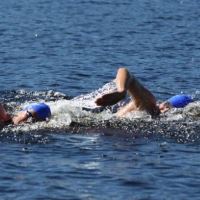-
Open water skill focus: Drafting
- Posted onjofrancis
- in Swimming, Website Articles
- onApril 25, 2017
- No Comments.
Drafting and its effect on a swimmer is similar to the draft experience in cycling. For cyclists the drafting effect exists because the lead cyclist is protecting the drafting cyclist from wind
 resistance. In the case of swimmers, it is (put very simply) water resistance.
resistance. In the case of swimmers, it is (put very simply) water resistance.Swimming in the slipstream of a swimmer will save you around 30% energy – you can either swim with less effort drafting off a swimmer of similar speed or swim faster for the same effort drafting off a faster swimmer.
The two most common drafting positions are either directly behind a swimmer or “on the hip” of a swimmer. Both have advantages and disadvantages.
1. On the toes. This is the easiest position to draft another swimmer. You need to get close, around 50 cm behind the swimmer’s toes but not so close that you touch them – or you will not be popular! Advantages are that it is easy to do. Disadvantages are that it is more difficult to sight when you are directly behind another swimmer and yet you need to – you cannot rely on the sighting of your lead swimmer. In addition, towards the end of the race, if your lead swimmer begins to kick harder the resulting eddy currents and additional water disruption can negate the drafting effect.
2. On the hip. This is a more advanced skill. The drafting swimmer swims so that their head is alongside the hip of the lead swimmer. There are differing opinions on whether to breathe to the hip side of the swimmer or away from the swimmer. It does not matter if the arms of the drafting swimmer are in sync with the lead swimmer. Advantages are that it is easier to sight when swimming on the hip than on the toes. Disadvantages are that it requires control to maintain the correct position very close alongside the lead swimmer.
Making full use of a drafting opportunity is an awesome experience resulting in a faster time using less energy. But a novice triathlete swimmer can become so focused on finding the right feet that they forget their stroke, their sighting and their pacing – all of those fundamental things that result in a good swim. You should know how to draft and take full advantage when the opportunity arises but don’t get obsessed with it. More advanced swimmers should ideally identify their lead swimmer at the start of the race – or be ready to jump onto a swimmer’s hip as they are overtaking.
If you enjoyed this article please consider sharing it!




